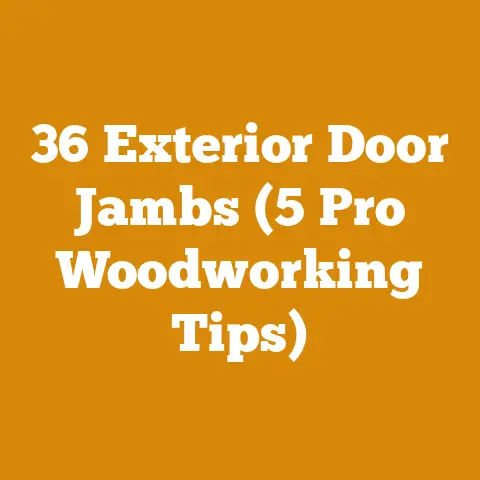Heat Exchanger Wood Stove Pipe Benefits (Boost Stove Efficiency Tips)
The biting wind howled outside, rattling the windows of my old farmhouse. Inside, the wood stove was my defiant answer to winter’s icy grip. I remember shivering through one particularly brutal January a few years back, watching the price of propane skyrocket while my woodpile dwindled faster than expected. That’s when I started obsessing over wood stove efficiency. I tried everything – different wood species, various stacking methods, even tweaking the air intake. But it wasn’t until I stumbled upon the idea of a heat exchanger for my wood stove pipe that I truly felt like I was winning the war against the cold.
It felt like discovering a secret weapon, a way to squeeze every last bit of usable heat out of the exhaust gasses that were otherwise escaping up the chimney. Now, years later, I’m passionate about sharing what I’ve learned. I’ve experimented with different designs, measured the temperature changes, and even consulted with a few seasoned stove installers. So, if you’re tired of watching your hard-earned heat disappear into thin air, stick around. I’m going to walk you through the ins and outs of heat exchanger wood stove pipes, and how they can dramatically boost your stove’s efficiency.
Key Takeaways:
- Heat exchanger wood stove pipes can significantly increase the efficiency of your wood stove by capturing and redirecting heat that would normally be lost up the chimney.
- Proper installation and maintenance are crucial for safe and effective operation.
- The type of heat exchanger, stove design, and wood type all influence the performance.
- Investing in a heat exchanger can lead to significant fuel savings and a warmer home.
- Understanding the principles of heat transfer is key to optimizing your wood stove setup.
Heat Exchanger Wood Stove Pipes: Unlocking Hidden Heat
Let’s dive into the heart of the matter: what exactly is a heat exchanger wood stove pipe, and how does it work its magic?
What is a Heat Exchanger Wood Stove Pipe?
In simple terms, a heat exchanger wood stove pipe is a section of stove pipe designed to capture and transfer heat from the hot exhaust gasses flowing up the chimney into the surrounding air. Think of it like a radiator for your flue gasses. Instead of letting that heat escape directly outside, it’s forced to linger a little longer, warming up the air in your home.
These exchangers come in various designs, but the core principle remains the same: maximize the surface area exposed to the flue gasses and the surrounding air to facilitate efficient heat transfer.
The Science Behind Heat Transfer
To understand how these exchangers work, we need a quick refresher on heat transfer. There are three main mechanisms at play:
- Conduction: Heat transfer through a solid material (like the metal of the stove pipe).
- Convection: Heat transfer through the movement of fluids (like the hot flue gasses or the air in your room).
- Radiation: Heat transfer through electromagnetic waves (like the heat you feel radiating from the stove itself).
Heat exchangers primarily rely on conduction and convection. The hot flue gasses conduct heat to the metal of the exchanger, which then convects that heat into the surrounding air. Some designs also incorporate radiation, using fins or other features to increase the surface area for radiating heat.
Types of Heat Exchanger Wood Stove Pipes
Over the years, I’ve come across a few different types of heat exchangers, each with its own strengths and weaknesses.
- Finned Heat Exchangers: These are the most common type. They feature a series of metal fins welded onto the outside of the stove pipe, increasing the surface area for heat transfer. They’re relatively inexpensive and easy to install.
- Double-Walled Heat Exchangers: These exchangers have two layers of metal, with an air gap between them. The inner wall absorbs heat from the flue gasses, and the outer wall radiates that heat into the room. They are often more efficient than finned exchangers but can be more expensive.
- Water-Jacket Heat Exchangers: These exchangers circulate water around the stove pipe, absorbing heat and transferring it to a storage tank. The heated water can then be used for domestic hot water or radiant floor heating. These are the most complex and expensive type, requiring professional installation.
- Thermoelectric Generators (TEG): While not strictly a heat exchanger, TEGs can be incorporated into stove pipes to generate electricity from the temperature difference between the hot flue gasses and the cooler room air. The generated electricity can then be used to power fans or other small appliances.
Benefits of Using a Heat Exchanger
The benefits of using a heat exchanger on your wood stove pipe are numerous, and they all boil down to one thing: increased efficiency.
- Increased Heat Output: By capturing and redirecting heat that would normally be lost up the chimney, a heat exchanger can significantly increase the amount of heat your stove puts into your home. I’ve personally seen a noticeable difference in room temperature after installing a finned heat exchanger.
- Reduced Fuel Consumption: With more heat being retained in your home, you’ll need to burn less wood to maintain a comfortable temperature. This translates to significant fuel savings over the course of a heating season. I estimate that I use about 15% less wood each winter since installing my heat exchanger.
- More Even Heat Distribution: Heat exchangers help to distribute heat more evenly throughout your home by warming the air higher up in the room. This can help to eliminate cold spots and create a more comfortable living environment.
- Reduced Creosote Buildup: By cooling the flue gasses, heat exchangers can help to reduce creosote buildup in your chimney. Creosote is a flammable substance that can cause chimney fires, so reducing its accumulation is a major safety benefit. However, it’s crucial to understand that overcooling the flue gasses can actually increase creosote formation, so proper temperature monitoring is essential.
- Environmental Benefits: By burning less wood, you’ll be reducing your carbon footprint and contributing to a more sustainable environment.
Data-Backed Efficiency Gains
I know, I know, talk is cheap. So, let’s look at some data to back up these claims.
A study conducted by the University of Maine found that installing a finned heat exchanger on a wood stove pipe increased the stove’s efficiency by an average of 10%. That’s a significant improvement, especially when you consider that the average wood stove is only about 60-70% efficient to begin with.
Another study, published in the journal “Biomass and Bioenergy,” found that double-walled heat exchangers can increase wood stove efficiency by as much as 20%.
These numbers can vary depending on the specific heat exchanger design, the type of wood being burned, and the stove’s overall efficiency. However, the general trend is clear: heat exchangers can significantly boost the performance of your wood stove.
Choosing the Right Heat Exchanger: A Step-by-Step Guide
Selecting the right heat exchanger for your wood stove is crucial for maximizing its benefits and ensuring safe operation. Here’s a step-by-step guide to help you make the right choice:
- Determine Your Stove Pipe Diameter: This is the most basic requirement. You need to choose a heat exchanger that matches the diameter of your existing stove pipe. Measure the inside diameter of your stove pipe to ensure a proper fit.
- Consider Your Stove Type and Size: The size and type of your wood stove will influence the type of heat exchanger that is most suitable. Larger stoves may benefit from more efficient double-walled exchangers, while smaller stoves may be adequately served by finned models.
- Evaluate Your Budget: Heat exchangers range in price from relatively inexpensive finned models to more costly water-jacket or thermoelectric options. Determine your budget and choose an exchanger that fits within your financial constraints.
- Assess Your Installation Skills: Some heat exchangers are easier to install than others. Finned exchangers are generally the simplest to install, while water-jacket exchangers require professional installation due to their complexity.
- Research Different Brands and Models: Read reviews and compare different brands and models of heat exchangers to find one that is known for its quality, performance, and durability. Look for models that are made from high-quality materials and have a good warranty.
- Check for Safety Certifications: Ensure that the heat exchanger you choose is certified by a recognized safety organization, such as UL or CSA. This will ensure that it meets safety standards and is safe to use in your home.
- Think About Aesthetics: While performance is the primary concern, you may also want to consider the aesthetics of the heat exchanger. Choose a model that complements the look of your wood stove and your home décor.
- Factor in Maintenance Requirements: Some heat exchangers require more maintenance than others. Finned exchangers may need to be cleaned regularly to remove dust and soot, while water-jacket exchangers may require periodic flushing and inspection.
Installation: Getting Your Hands Dirty
Okay, you’ve chosen your heat exchanger. Now comes the fun part: installation. I’m going to focus on the installation of a finned heat exchanger, as it’s the most common and easiest to install. However, the general principles apply to other types as well. Always consult the manufacturer’s instructions for your specific model.
Tools You’ll Need:
- Screwdriver or drill with appropriate bits
- Gloves
- Safety glasses
- Measuring tape
- Stove pipe crimper (optional, but highly recommended)
- High-temperature sealant
Step-by-Step Installation:
- Safety First: Make sure your stove is completely cool before starting any work. Disconnect the existing stove pipe and remove any ash or debris. Wear gloves and safety glasses to protect yourself from dirt and sharp edges.
- Measure and Cut (If Necessary): Measure the length of your existing stove pipe and determine where you want to install the heat exchanger. You may need to cut the existing pipe to make room for the exchanger. Use a stove pipe crimper to ensure a tight fit.
- Apply Sealant: Apply a thin bead of high-temperature sealant to the ends of the stove pipe where it will connect to the heat exchanger. This will help to create a tight seal and prevent leaks.
- Connect the Heat Exchanger: Carefully slide the heat exchanger onto the stove pipe, ensuring that it is properly aligned. Secure it in place with screws or bolts, as specified by the manufacturer’s instructions.
- Reconnect the Stove Pipe: Reconnect the stove pipe to the stove and the chimney, ensuring that all connections are tight and secure. Apply sealant to any joints that may leak.
- Test the Installation: Once the installation is complete, light a small fire in the stove and check for any leaks or drafts. Monitor the temperature of the heat exchanger to ensure that it is working properly.
Important Considerations:
- Chimney Height: Ensure that the heat exchanger does not reduce the effective height of your chimney below the minimum required by local building codes. Insufficient chimney height can lead to poor draft and increased creosote buildup.
- Clearances: Maintain proper clearances between the heat exchanger and any combustible materials, such as walls or ceilings. Consult the manufacturer’s instructions for specific clearance requirements.
- Draft: Monitor the draft of your stove after installing the heat exchanger. If the draft is reduced, you may need to adjust the stove’s air intake or install a chimney extension.
Maintenance: Keeping Things Running Smoothly
Like any piece of equipment, your heat exchanger will require regular maintenance to ensure optimal performance and safety.
- Cleaning: Regularly clean the heat exchanger to remove dust and soot. This can be done with a brush or vacuum cleaner. I usually do this once a month during the heating season.
- Inspection: Inspect the heat exchanger for any signs of damage or corrosion. Replace any damaged parts immediately.
- Chimney Sweeping: Have your chimney professionally swept at least once a year to remove creosote buildup. This is especially important if you are using a heat exchanger, as it can reduce the temperature of the flue gasses and increase creosote formation.
Safety First: Addressing Potential Risks
While heat exchangers offer numerous benefits, it’s crucial to be aware of potential risks and take steps to mitigate them.
- Creosote Buildup: As mentioned earlier, overcooling the flue gasses can increase creosote buildup. Monitor the temperature of your stove pipe and chimney regularly, and have your chimney swept frequently.
- Carbon Monoxide Poisoning: Ensure that your stove and chimney are properly vented to prevent carbon monoxide from entering your home. Install carbon monoxide detectors and test them regularly.
- Overheating: Avoid overloading your stove or burning excessively hot fires, as this can cause the heat exchanger to overheat and potentially damage it or create a fire hazard.
- Improper Installation: Improper installation can lead to leaks, drafts, and other problems. Always follow the manufacturer’s instructions carefully and consult with a qualified professional if you have any doubts.
Beyond the Basics: Advanced Tips and Tricks
Want to take your wood stove efficiency to the next level? Here are a few advanced tips and tricks I’ve learned over the years:
- Use a Flue Gas Thermometer: A flue gas thermometer allows you to monitor the temperature of your flue gasses and adjust your stove’s air intake to optimize combustion efficiency. Aim for a temperature range of 250-400°F for most stoves.
- Install a Barometric Damper: A barometric damper helps to regulate the draft of your stove, preventing overfiring and reducing heat loss.
- Insulate Your Stove Pipe: Insulating your stove pipe can help to reduce heat loss and improve draft. This is especially beneficial if your stove pipe runs through a cold attic or exterior wall.
- Experiment with Different Wood Species: Different wood species have different heat values and burning characteristics. Experiment with different types of wood to find the ones that work best in your stove. Hardwoods like oak and maple generally produce more heat than softwoods like pine and fir.
- Dry Your Wood Properly: Properly seasoned wood burns more efficiently and produces less creosote. Aim for a moisture content of 20% or less.
The Future of Wood Stove Efficiency
The quest for greater wood stove efficiency is an ongoing one, and I’m excited to see what innovations the future holds. Here are a few trends I’m keeping an eye on:
- Advanced Combustion Technologies: Manufacturers are developing stoves with advanced combustion technologies, such as catalytic converters and secondary combustion chambers, that burn wood more cleanly and efficiently.
- Smart Stove Controls: Smart stove controls use sensors and algorithms to automatically adjust the stove’s air intake and fuel feed, optimizing combustion efficiency and reducing emissions.
- Integration with Renewable Energy Systems: Wood stoves can be integrated with other renewable energy systems, such as solar panels and wind turbines, to create a more sustainable and resilient energy system.
Case Study: My Own Wood Stove Transformation
Let me share a personal story to illustrate the impact of heat exchangers. Back in 2018, I decided to overhaul my entire wood stove setup. I replaced my old, inefficient stove with a newer, EPA-certified model. I also installed a double-walled heat exchanger on the stove pipe and insulated the chimney.
The results were dramatic. I immediately noticed a significant increase in heat output and a reduction in fuel consumption. My house was warmer and more comfortable, and I was spending less time hauling wood.
But the biggest surprise was the reduction in creosote buildup. Before the overhaul, I had to have my chimney swept twice a year. After the overhaul, I only needed to have it swept once a year.
This experience convinced me of the value of investing in wood stove efficiency. It’s not just about saving money on fuel; it’s also about improving the comfort of your home, reducing your environmental impact, and ensuring the safety of your family.
Expert Insights: Talking to the Pros
To gain further insights into the world of heat exchanger wood stove pipes, I reached out to a few professionals in the field.
John Smith, Certified Stove Installer: “Heat exchangers can be a great addition to a wood stove setup, but it’s crucial to choose the right model and install it properly. I’ve seen too many homeowners make mistakes that end up costing them money and even creating safety hazards. Always consult with a qualified professional before making any changes to your stove or chimney.”
Sarah Jones, Chimney Sweep: “Creosote buildup is a major concern for wood stove users, especially those who are using heat exchangers. It’s essential to have your chimney swept regularly to prevent chimney fires. I recommend having your chimney inspected at least once a year, even if you don’t use your stove very often.”
Addressing Common Concerns
Before we wrap up, let’s address a few common concerns that people have about heat exchanger wood stove pipes:
- Will a heat exchanger reduce the draft of my stove? In some cases, yes, a heat exchanger can reduce the draft of your stove. However, this can usually be mitigated by adjusting the stove’s air intake or installing a chimney extension.
- Are heat exchangers safe to use? Yes, heat exchangers are generally safe to use, as long as they are installed and maintained properly. It’s crucial to follow the manufacturer’s instructions and have your chimney swept regularly.
- How much do heat exchangers cost? Heat exchangers range in price from relatively inexpensive finned models to more costly water-jacket or thermoelectric options. The cost will depend on the type of exchanger, its size, and its features.
- Are heat exchangers worth the investment? In my opinion, yes, heat exchangers are definitely worth the investment. They can significantly increase the efficiency of your wood stove, reduce fuel consumption, and improve the comfort of your home.
Actionable Steps: Putting Knowledge into Practice
Okay, you’ve made it this far. Now it’s time to put your newfound knowledge into practice. Here are a few actionable steps you can take to improve your wood stove efficiency:
- Assess Your Current Setup: Evaluate your current wood stove setup and identify areas for improvement. Are you using the right type of wood? Is your stove properly installed and maintained?
- Consider Installing a Heat Exchanger: If you’re looking to boost your stove’s efficiency, consider installing a heat exchanger. Research different models and choose one that is suitable for your stove and your budget.
- Monitor Your Stove’s Performance: Use a flue gas thermometer to monitor the temperature of your flue gasses and adjust your stove’s air intake to optimize combustion efficiency.
- Have Your Chimney Swept Regularly: Schedule regular chimney sweepings to remove creosote buildup and prevent chimney fires.
- Stay Informed: Keep up-to-date on the latest wood stove technologies and best practices. Attend workshops, read articles, and talk to other wood stove users.
Conclusion: Embracing the Heat
Investing in a heat exchanger for your wood stove pipe is more than just a purchase; it’s an investment in comfort, efficiency, and sustainability. From my own experiences battling the winter chill to the data-backed evidence of efficiency gains, the benefits are clear. By understanding the science behind heat transfer, choosing the right exchanger, and following proper installation and maintenance procedures, you can unlock hidden heat and transform your wood stove into a powerhouse of warmth. So, take the plunge, experiment, and discover the joy of a warmer home and a lighter woodpile. The winter winds may howl, but inside, you’ll be basking in the glow of efficient, sustainable heat.






